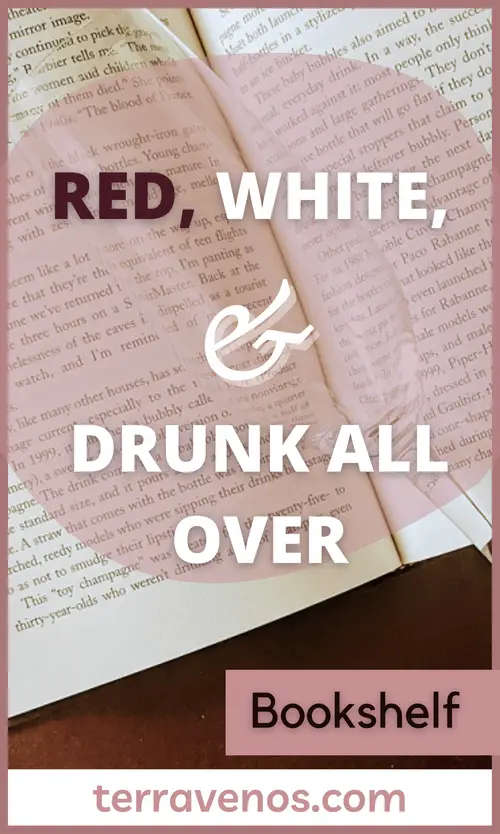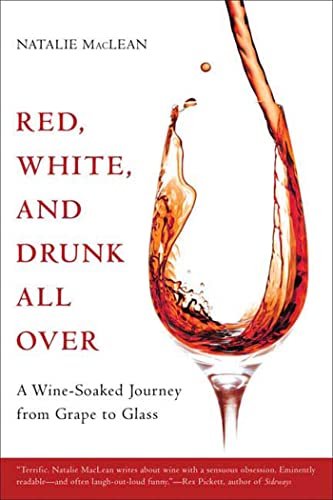
Wine Book Review: Red, White, and Drunk All Over
Author: Natalie MacLean
Who’s Natalie MacLean?
Author Natalie MacLean has topped my list of recent discoveries for wine writers. Winner of four James Beard Journalism Awards and the World’s Best Drink Writer, she embodies enthusiasm for vino like few others.
Natalie MacLean is every wine lover’s private behind-the-scenes guide to the world of wine. Sip through the pages of this easy-reading book and learn along with me
Red, White, and Drunk All Over
Her book Red, White, and Drunk All Over (2006) chronicles adventures in the wine world with interviews, diatribes, and dinner tales (link to Amazon).
I shall begin with an excerpt to illustrate. On her visit to Champagne, MacLean writes:
That ability to reinvent and rebuild is a big part of the region’s success. Still, as with many culinary luxuries, the product itself is so labor-intensive and costly that you wonder how anyone could ever have thought of it in the first place. It sounds like something that laid-off marketing executives would dream up in a skills retraining workshop:
“First, we’ll find one of the coldest climates on earth for growing grapes; and then we’ll plant red ones, even though we want to make white wine. We’ll be completely dependent on top-quality grapes but we won’t actually own any vineyards-we’ll just have fun negotiating every year with the grape growers. Then, when it’s time to make the wine, we’ll do it not once but twice: we’ll ferment it in the fall and again in the spring.
“Over the winter, we’ll stand the bottles nearly upside down in massive racks and give them a quick turn every day for about eight weeks until all the goopy dead-yeast stuff slides into the neck. Then we’ll freeze the top and let that stuff fly out. We’ll add some sweetened wine, then recork it and wait for it to ages somewhere between three and twenty-five years or so. Voila! Champagne in three hundred easy steps!
What I truly love about MacLean’s writing from the perspective of a wine student is that she weaves industry knowledge into her narrative, dropping historical references, marketing tactics, and international trade legalities – all topics that make wine textbooks rather drab – crafting a rich and rewarding storyline.
In the same chapter on Champagne, you learn that after the industrial revolution, the winegrowers struggled to find manure for their vineyards.
They resorted to importing garbage from Paris to use as compost, which worked in the early days of industrialization but became problematic as people started using more inorganic plastics.
The practice was finally discontinued in 1997, but not before bits of plastic wound up in some of the world’s greatest vineyard plots.
These sorts of details and first-hand accounts bring the wine world to life for students and enthusiasts alike.
In her chapter Purple Prose with Bite, she dives into the polemics between some of the greatest wine writers of our day: Robert Parker and Jancis Robinson – peeling back their roles as outsized influencers who have literally changed how you and I buy wine.
Seriously. These two have influence.
Parker tells MacLean, “Early on in my career, producers offered me Napoleonic music boxes, a Porsche, and their daughters” (p. 118).
MacLean walks you through the different mantels wine writers can wear:
Are they to be dispassionate, objective reviewers of wine, far removed from the winemaker and producer to better offer unbiased advice to the consumer?
Or should they be linked to the growers and producers to learn their stories so that they can better communicate with consumers?
You can decide.
For the more practical wine lovers among you, MacLean includes a chapter called Undercover Sommelier, where she moonlights as a sommelier for one night at the award-winning Le Baccara in Quebec.
Hilarious details on corkscrews, foil, and customers aside, she does offer keen advice on figuring out a restaurant’s wine markup and the best value for price using her very own Wolf Blass Yellow Label Index.
It’s simple:
Start with a standard wine for which you know the retail price. In MacLean’s case, it was an Australian Cabernet Sauvignon – Wolf Blass Yellow Label. If you know the price difference between retail and the restaurant, you can generally figure out the price markup on the other wines.
Here in the US, Meomi would be a solid wine list choice for your personalized index.
This seems like a clever tactic that’s worth putting to the test the next time I’m dining out.
In chapter 6, you get the pleasure of tagging along with our intrepid author for a tasting with George Riedel, of Riedel glass fame.
Stemware has never been so captivating. I’ve heard of the Riedel tasting challenges where a wine is presented in different shaped glasses and you can smell the difference in how the wines present themselves.
Anecdotal accounts will swear that glasses make a difference, but as a frugal skeptic, MacLean’s description resonates with me:
Riedel’s advice on choosing stemware reminds me of those diamond commercials that advise you to spend two month’s pay on the engagement ring, if you really love her.
Personal note: I didn’t know there was something called the “upscale stemware market” before reading this book. I do now.
Final Thoughts: Red, White, and Drunk All Over
Red, White, and Drunk All Over (#ad) is an authentic journey into the world of wine that will pair beautifully with your afternoon rosé or evening tipple. Our author’s inquisitive nature and witty prose will leave feeling like you’ve just enjoyed a wonderful bottle of wine over dinner with friends – warm and content. MacLean captures this more poetically:
Hospitality is one of life’s greatest pleasures. It gets us out of our separate solitudes and gathers us together to celebrate special occasions, to enjoy good food and wine, and to brighten otherwise ordinary evenings.
Highly recommend.
Thirsty for More?
Check out The Emporer of Wine that explores the rise of Robert Parker and the 100 point wine rating scale.





